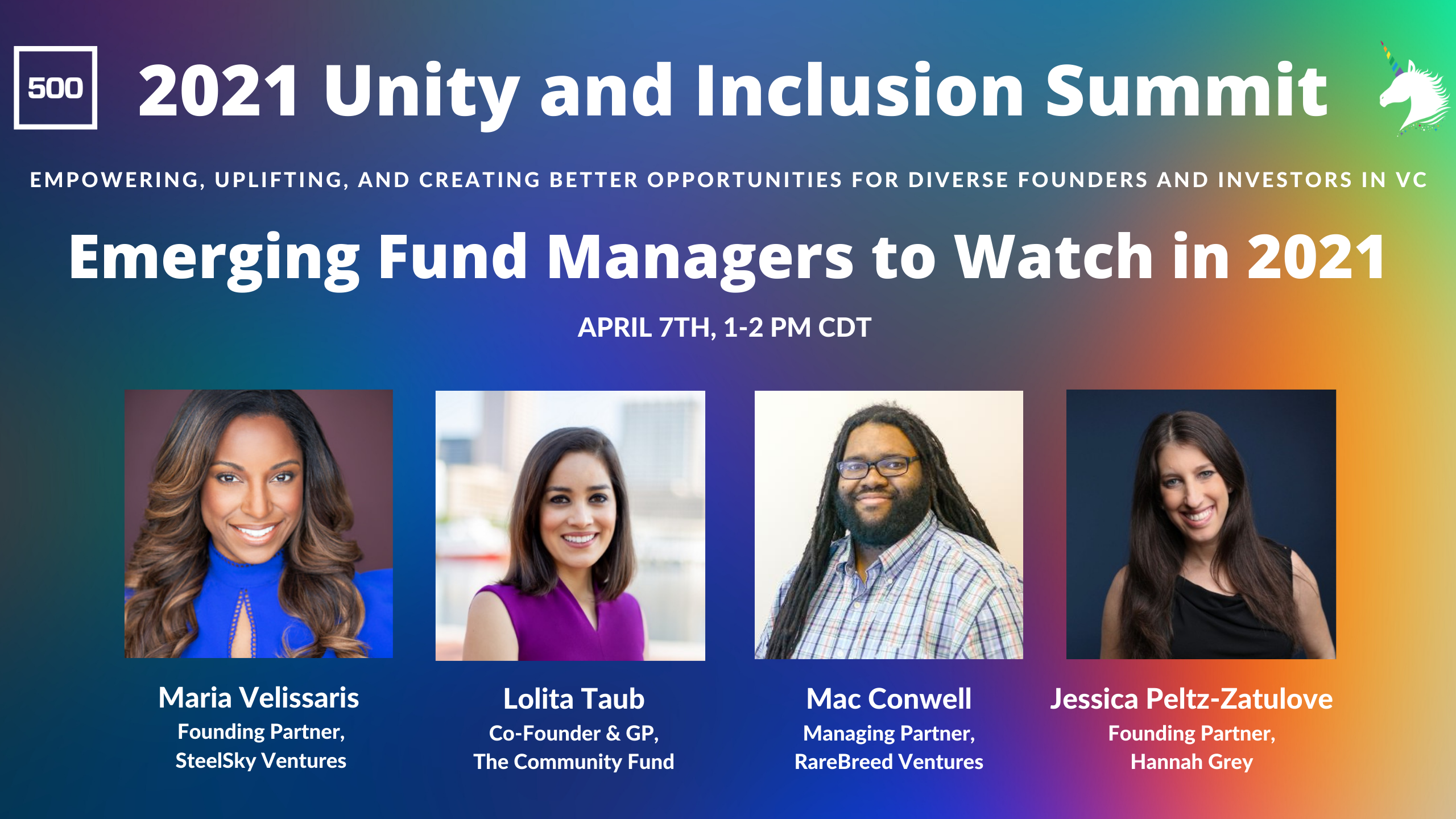We spoke to Mac Conwell, Maria Velissaris, Lolita Taub and Jessica Peltz-Zatulove.
2021.04.23

500 Global Team

Four emerging fund managers gathered recently at 500 Startups’ 2021 Unity and Inclusion Summit to discuss what it takes to break into VC, forge relationships with LPs and build diverse founder pipelines.
The talk featured McKeever “Mac” Conwell, a two-time founder and former investor for the state of Maryland who launched RareBreed Ventures, a pre-seed and seed fund investing primarily outside major tech hubs; Maria Velissaris, an entrepreneur and operator who is a founding partner of SteelSky Ventures, which invests in late seed and Series A companies focused on women’s healthcare; Lolita Taub, a VC industry vet who’s a co-founder and GP at The Community Fund, which backs pre-seed and seed companies focused on community building; and Jessica Peltz-Zatulove, a corporate VC, who recently founded Hannah Grey, a first check fund focusing on customer-centric founders.
Here are key insights they shared:
Brand Building
RareBreed’s Conwell embraces a brand building approach that leverages social media. “I’m raising my fund because of Twitter,” he said. He’s prolific on the platform, relying on it to build relationships and share his viewpoints with companies, VCs and LPs. Tangible result: He received an LP commitment from a connection forged on Twitter.
Carving out a specific niche helps. SteelSky is one of the few funds focused on women’s healthtech, which sets them apart. When investors come across a company in that space, for instance at a pitch competition, many automatically think of SteelSky. “They just send it straight to us, because of how we’ve defined our lane very narrowly,” said Velissaris.
For Hannah Grey’s Peltz-Zatulove it’s all about rolling up her sleeves and working with entrepreneurs. “I am known for helping startups get their first customers and learning how to commercialize your business,” she said. She also draws on her experience as co-founder of Women in VC, a networking group with more than 3,000 women investors across more than 2,000 venture funds worldwide. “That’s been a helpful source for co-investors, for collaborators, for deal flow and just genuine community building,” she said.
Taub highlights the need to identify a unique perspective or edge. “What is that thing you are going to be known for?” she said. “That area should parallel with your thesis.” Similar to Conwell, she cites Twitter as a powerful branding tool that helps make up for a lack of social capital, something she didn’t initially have access to as a first generation Mexican-American breaking into VC. Taub also points out that emerging fund managers need to remember they’re building their brand around three distinct customers: startups, co-investors and LPs.
Getting Funded
As these emerging fund managers have found, building relationships with LPs takes time and energy and comes with plenty of rejections; it can be easy to waste a lot of time fundraising if you’re not careful. That means learning to focus on realistic LP targets and moving on quickly when they’re not panning out, while recognizing that money can come from unexpected places. “I’m not chasing people who say no five times,” says Velissaris. “I’m gonna go find people that want to make money with me.”
Do your research upfront and save time, she says. That can simply mean searching Pitchbook for LPs who provide capital for funds under $50 million, who has dry powder and so on. For a first fund, Velissaris recommends family offices, high net-worth individuals and GPs, while avoiding consultants (a.k.a. those who filter funds on behalf of endowments, foundations and large organizations to help de-risk their investments). She finds consultants probably won’t take a chance on a first time fund manager.
Although Peltz-Zatulove finds that institutional investors usually don’t back funds under $100 million, it can be instructional to take meetings with them. Even when an investor passes, she still questions them on what resonated about her pitch or what didn’t. “We are competitive students and we want to win,” she says. Ultimately, getting funding is about being scrappy and talking with many different people. She recommends following up on every conversation with an LP, but not to worry about chasing if they’re not leaning in. “If they want to talk to you, they’ll find you,” she says. “If not cut bait, throw them on your quarterly update list.”
Conwell suggests focusing on networking with fellow VCs. Some GPs will make direct investments as LPs into emerging fund managers with a smart approach.
He also highlights VC training programs, something all four managers on the panel pursued. For instance, he and Velissaris both participated in VC Unlocked in 2019, a program hosted by 500 Startups and Stanford. Alongside training, Conwell points to helpful connections forged during the program: both he and Velissaris report that classmates from VC Unlocked are now LPs in their funds.
Building Diverse Pipelines
The array of emerging managers on this panel represents in many ways the changing face of VC, but Conwell cautions there’s still work to be done. “There are still biases that exist,” he said. “Don’t get fooled by what’s happened over the last year.”
It helps that these managers are making an impact by building diverse pipelines. At SteelSky, which has a portfolio consisting entirely of either women or people of color, Velissaris finds that diverse founders seek them out because her firm resonates in a way the average Sand Hill Road VC firm doesn’t. “My networks are diverse by definition because I’m a diverse person,” she said. “They see me in women’s healthcare, they see me as a black person and they feel more comfortable approaching me as a VC.”
Taub is making an impact here by developing a free matching tool for investors and underrepresented founders. Using thesis information submitted by investors and info from founders, the tool identifies potential matches and links them up. “In less than a year we’ve seen 24 checks written with a value of over $3.8 million,” she said.
Peltz-Zatulove reports that 65% of Hannah Grey’s portfolio are either women or people of color, and they’ve taken a data-oriented approach to building a diverse pipeline. They collect data from companies through an online form, which helps identify blind spots and areas they need to grow. They’ve also started mentoring diverse emerging fund managers themselves, giving them insight on interesting perspectives and dealflow.
Another part of the equation is building relationships with different investors across the capital stack. That’s an area Conwell is focused on. He’s working to facilitate access to downstream capital for diverse founders in his pipeline by building relationships with co-investors and funders at later stages.
Ultimately, part of channeling funding to diverse founders is about changing who controls the capital. The numbers still point to a need for major progress here. Through research it conducted last year, Hannah Grey found that only 5.6% of VC firms in the U.S. were owned by women.
“The good news is there’s an incredible swath of new emerging managers that are women and are people of color,” says Peltz. “Giving them the same support and attention and helping them expand their capital network is just going to help the entire ecosystem.”
This post is intended solely for general informational or educational purposes only. 500 Startups Management Company, L.L.C. and its affiliates (collectively “500 Startups”) makes no representation as to the accuracy or information in this post and while reasonable steps have been taken to ensure that the information herein is accurate and up-to-date, no liability can be accepted for any error or omissions. All third party links in this post have not been independently verified by 500 Startups and the inclusion of such links should not be interpreted as an endorsement or confirmation of the content within. Under no circumstances should any content in this post be construed as investment, legal, tax or accounting advice by 500 Startups, or an offer to sell or solicitation of interest to purchase any securities advised by 500 Startups. Prospective investors considering an investment into any 500 Startups fund should not consider or construe this content as fund marketing material. The views expressed herein are as at the date of this summary and are subject to change without notice. This post includes the views and opinions of independent third parties that are not related to or controlled by 500 Startups. All views and opinions presented herein by such third party participants do not represent those of 500 Startups or any of its affiliates or representatives. 500 Startups makes no representations as to or guarantees of specific outcomes from relying on the contents of this post.




